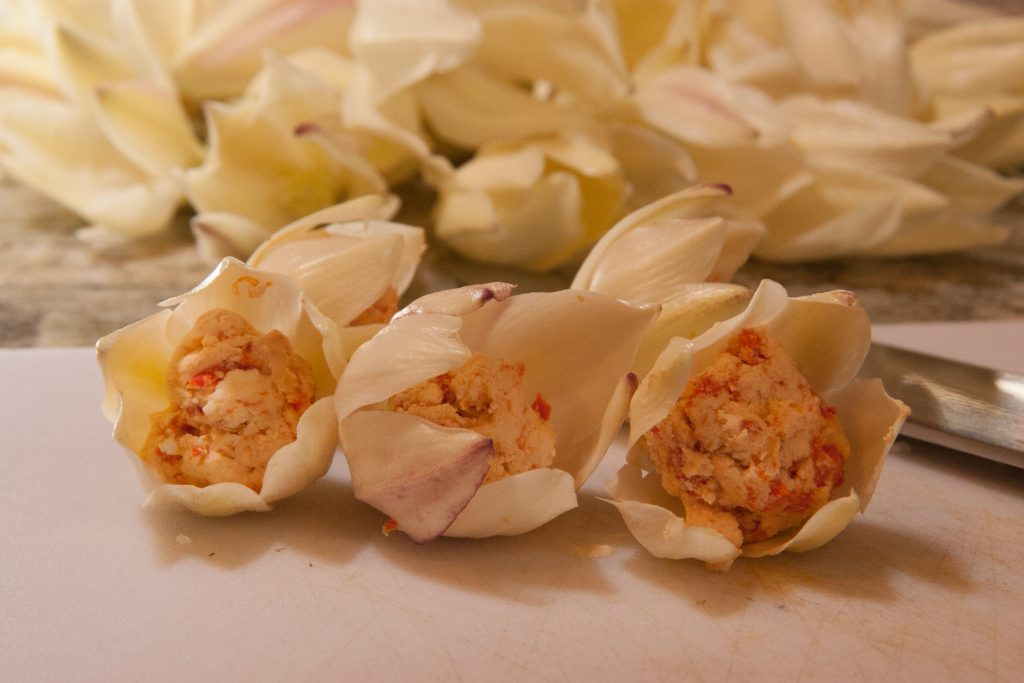
Yucca flowers are perfect little bite-sized packages, so why not fill them with something delicious? Start with a cream cheese base, then add your choice of flavorings.
In Latin America, yucca flowers are a traditional food, often cooked with eggs or tomato sauce. I haven’t tasted every species, but they’re all considered edible. Some people get an itchy throat when eating the flowers raw, and some people eat only the petals, not the pistils and stamens inside. I eat the whole flower, both raw and cooked with no trouble at all.
You’ll use the whole yucca flower in this recipe, but remove the pistils and stamens first. Grasp them at the base where they join the flower and give a quick twist. These flower parts cook more slowly than the flower petals, so we’ll give them a head start.
What You’ll Need to Make Stuffed Yucca Blossoms
- rinsed yucca flowers, pistils and stamens removed and reserved
- 1/2 cup cream cheese, room temperature
- 1/2 tsp. salt
- 1/2 tsp. ground sumac
- 1/4 cup chopped onions
- 2 Tbs. chopped green chiles (if you’re not a fan of spicy food, you can substitute chopped, roasted red peppers)
- flour
- 1 egg (beaten)
What You’ll Need to Make Stuffed Yucca Blossoms
Roughly chop the yucca pistils and stamens and the onion, and sauté in olive oil until the onions are translucent. The pistils and stamens may (or may not) turn green. Add the salt, sumac powder, and whichever kind of pepper you prefer, and stir to combine, then remove from the heat. You don’t need to cook the spices and peppers, just warm them up a little.
In a bowl, fold the warmed ingredients into the cream cheese.
Place a teaspoon of the cheese mixture inside each yucca flower and gently press the flowers closed. Dip each flower in the beaten egg, then lightly dredge in flour and set aside.
In a clean sauté pan, add some more olive oil and fry the stuffed blossoms until the cream cheese becomes soft and melty, and the outside of each flower is a crispy golden brown. Serve warm.

Where do you find Yucca flowers
I’m not sure that telling you where I find them will help you, unless you’re also in Santa Fe, NM. It’s still a little early for the blooms, but I find them all over the local hiking trails, in open spaces, parks, and gardens. I’ve even planted some at home, specifically for the flowers and fruits. Where are you located?
I’m in Vero Beach Florida, I would love to get my hands on seeds but I keep running into dead ends here..Thank you
If you can’t order seeds or buy plants, maybe you can forage for some seeds. I don’t know when they bloom in Vero Beach, but you’ll notice the seed pods when they form. You want to harvest a few pods when they turn brown, but before they split open.
Strictly Medicinal Seeds has Yucca seeds.
Does harvesting the flowers prevent the plant from creating the fruits? Isn’t that a problem for the food source that yucca provides for local animals and birds?
I am SO GLAD you asked that question, because it’s one I just wrote about in the book I’m working on. Yucca only fruits every 3-4 years (in general) because it takes a lot out of the plant to produce the fruit. So there are a couple of ways to approach this. 1) If you absolutely don’t want to take any chance of reducing the fruit crop, you can pick the petals individually, leaving the pistils and stamens behind (for pollination and fruit formation). Foragers often do this with plants like roses, yuccas, and pineapple guava, so they can harvest both petals and fruit. Of course, then you’d have to sautée the flowers, not stuff them, because you’d be working with individual petals, not a cup-like flower. 2) If you harvested a bumper crop of yucca fruit last year, it’s pretty likely your plants will be taking a break this year and producing only flowers, no fruit. So that would be a good year to harvest reasonably. 3) And of course, if you live someplace where there are wall-to-wall yucca plants, you could harvest a small amount in any year, leaving plenty behind for wildlife, for the species to propagate itself, and for your fellow foragers.